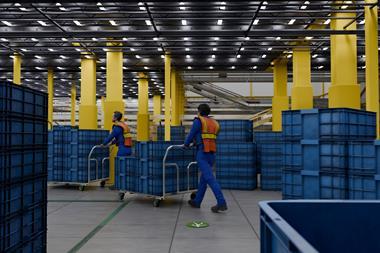A supplier going bust has always been a logistical nightmare for retailers, but at the moment it is happening alarmingly often. Charlotte Hardie assesses how to minimise the impact
You may have lost count of the number of retailers that have hit the buffers in recent months, but you would probably struggle to grasp the number of suppliers that have met a similar fate.
In China alone, tens of thousands of factories have shut in the past year. And, of course, China is not the only country whose manufacturing industry is facing problems. Every day, retailers’ product suppliers all over the world are going bust, and the problem will only escalate as the global economy worsens.
Unless retailers are prepared, the impact can be disastrous. Aside from the obvious risk of product shortages it can result in unfulfilled orders, lost sales, shopper dissatisfaction and even the loss of loyal customers.
John Lewis head of product sourcing Sean Allam says that while such collapses have always happened in global supply chains, “it’s certainly more of an issue than it was 12 months ago, and it occupies more of our time”.
Ironically, improvements in retailers’ supply chains have actually complicated the situation. Will Bruce, principal consultant at retail risk adviser Marsh, says: “Because there is so much just-in-time order fulfilment, the time between a supplier going bust and the impact of it being felt is very short.”
So how can retailers minimise the risk and prepare themselves for this happening to them?
Better contingency planning is vital. Dan Kelmanson, senior associate within Pinsent Mason’s restructuring team, says: “You’re going to struggle to come out of it in decent shape if you wait until one of your suppliers goes into an insolvency procedure.”
There are a few obvious warning signs that might indicate a supplier is in trouble. Are you getting orders on
time and to specification, for instance? Are suppliers desperate for advance payment? Are they giving away percentage rebates like there’s no tomorrow?
A thorough, accurate picture can only emerge with a detailed risk assessment system. This is where many retailers struggle. Bruce says: “Where many companies have failed so far is that procurement departments are very good at what they’re doing but risk management often sits separately from procurement – the two need to be aligned.”
To help identify which suppliers are most at risk, it is vital that procurement teams carry out the necessary due diligence of their supplier base. Retailers might think they are doing this perfectly efficiently already but, chances are, many are not. Larger businesses will have sophisticated – often outsourced – supply monitoring programmes.
John Lewis does just that. Notably, the retailer is updating information on suppliers far more frequently since their vulnerability has increased. Allam says: “It used to be every one or two years, but for the high-risk ones we’re now doing that every six to eight weeks.”
Monitoring programmes are often effective at keeping an eye on direct suppliers, but what about those further along the supply chain? Bruce believes more retailers need to map things out right down to tier-two and tier-three suppliers. “You might have a strong supplier that is in turn supplied by a very weak one,” he points out.
However, retailers will undoubtedly question whether or not this is logistically possible in all cases and Allam believes it is not. “John Lewis has a big tier-one supply base. To get even into tier two is far more complicated.” Furthermore, he believes “that’s our suppliers’ responsibility”.
Once you have identified those suppliers most at risk, it is vital to ensure there are reliable alternative suppliers that could be called upon. Kelmanson says: “The extent of the damage caused by a supplier going bust will depend on the alternative suppliers available, how quickly those alternatives can be used and at what cost.” Clearly, for larger retailers with thousands of suppliers, it would not be possible to have this
kind of fallback for every one of them. However it is possible to prioritise which ones are most critical, such as those that supply multiple products.
Alastair Charatan, director of retail supply chain consultancy EOC Consulting, recommends spending time familiarising yourself with alternative suppliers. “If a supplier is supplying your competitors and it goes under, all those competitors are going to suddenly hit the phones. If you’re even a day quicker off the mark in terms of who to call and exactly which products you’re interested in, that will give you a competitive advantage.”
Supply chain and buying teams also need to be aware of legal details. This doesn’t mean knowing the ins and outs of every contract, but it does mean having an overview. In some cases it may be in an administrator’s interests to continue to supply in order to preserve a business as a going concern, but it might also result in the automatic termination of a contract. Equally, the particulars of the contract could mean that the goods remain the property of the supplier. Thus the first thing an administrator might do is demand their goods back.
Kelmanson says: “Retailers will be hit harder if they don’t know what mechanisms they have in their contract that could work in their favour.”
He adds: “Communication is so important. There’s no point in someone in some dark corner of the retailer’s building having access to this information if the people on the ground don’t know anything about it.”
Once risky suppliers have been highlighted, retailers could also look at stockpiling – if possible – certain categories in the warehouse. Allam says: “We look at what sort of stock cover we have for high-risk areas. Where we might normally hold a week’s stock, we might increase that to six or eight weeks.”
Charatan adds that when suppliers suspected of being in trouble offer amazing deals, they are worth serious consideration. “If you’re able to store huge deliveries of product for, say, six months at a greatly reduced price, it might be worth it. If the supplier does go bust in that time, you’ve got the stock and it gives you time to find another supplier without interrupting supply.”
Most importantly, however, retailers should look at the wider problem of suppliers going bust and consider whether they might actually be making the problem worse. In a Retail Week online poll this week, more than two thirds of respondents said they did not believe retailers were pushing suppliers too hard for lower prices.
Retailers might think it makes sense to push suppliers ever harder for discounts and extended payment terms, but does it? Large, successful retailers are able to get hold of money cheaply if they need it; smaller suppliers usually can’t. So the money they need to raise to tide them over when retailers demand ever longer payment times makes their lives even harder.
As Charatan says: “It’s counter-productive if a retailer says, ‘I’m going to pay you in 90 days’, because that supplier needs to get hold of expensive cash. Actually, if the retailer says ‘if you give me a great deal I’ll pay you on delivery’, everyone’s a winner.”
This won’t be possible for all retailers because of banking covenants, but they need to consider whether what they deem to be expedient financial negotiations are in fact a short-sighted strategy that places everyone involved in a worse situation. Bruce says: “If a supplier only has X amount of product, a lot will depend on the strength of the supplier relationship. You have to consider whether they will go to one of your competitors first.”
When it comes to pre-empting the demise of a supplier, retailers can never be too prepared. The trading climate is difficult enough as it is. The last thing businesses want is to lose vital sales and customers simply due to lack of focus.
Supplier risk the nuts and bolts
- Product manufacturers around the globe are failing. China’s problems are particularly well documented. Last month, its exports plunged by a record 25.7 per cent compared with the same month last year.
- Decreased lead times through improvements in retailers’ transport and logistics, as well as increases in just-in-time order fulfilment, have increased the risk for retailers.
- Problems arising from a supplier going bust include gaps on the shelves, failed order fulfilment and dissatisfied customers who may well defect to competitors.
- Retailers need to improve supply monitoring programmes and update their systems with information on high-risk suppliers far more frequently.
- Line up, and familiarise yourself with, alternative suppliers. However, ensure that you don’t risk spreading unnecessary rumours about a supplier that could exacerbate the problem.
- Consider whether demands for extended payment terms are actually putting your suppliers more at risk.


























No comments yet